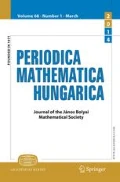Abstract
A family {A i | i ∈ I} of sets in ℝd is antipodal if for any distinct i, j ∈ I and any p ∈ A i , q ∈ A j , there is a linear functional ϕ:ℝd → ℝ such that ϕ(p) ≠ ϕ(q) and ϕ(p) ≤ ϕ(r) ≤ ϕ(q) for all r ∈ ∪i∈I A i . We study the existence of antipodal families of large finite or infinite sets in ℝ3.
Similar content being viewed by others
References
K. Bezdek, T. Bisztriczky and K. Böröczky, Edge-antipodal 3-polytopes, Discrete and Computational Geometry (J. E. Goodman, J. Pach, and E. Welzl, eds.), MSRI Special Programs, Cambridge University Press, 2005.
T. Bisztriczky and K. Böröczky, On antipodal 3-polytopes, Rev. Roumaine Math. Pures Appl., 50 (2005), 477–481.
L. Danzer and B. Grünbaum, Über zwei Probleme bezüglich konvexer Körper von P. Erdős und von V. L. Klee, Math. Z., 79 (1962), 95–99.
P. Erdős, On extremal problems of graphs and generalized graphs, Israel J. Math., 2 (1964), 183–190.
R. L. Graham, B. L. Rothschild and J. H. Spencer, Ramsey Theory, Wiley, New York, 1990.
B. Grünbaum, Strictly antipodal sets, Israel J. Math., 1 (1963), 5–10.
V. Klee, Unsolved problems in intuitive geometry, Mimeographed notes, Seattle, 1960.
E. Makai, JR. and H. Martini, On the number of antipodal or strictly antipodal pairs of points in finite subsets of ℝd, Applied geometry and discrete mathematics, DIMACS Ser. Discrete Math. Theoret. Comput. Sci. 4, Amer. Math. Soc., Providence, RI, 1991, 457–470.
E. Makai, JR. and H. Martini, On the number of antipodal or strictly antipodal pairs of points in finite subsets of ℝd. II, Period. Math. Hungar., 27 (1993), 185–198.
H. Martini and V. Soltan, Antipodality properties of finite sets in Euclidean space, Discrete Math., 290 (2005), 221–228.
A. Schürmann and K. Swanepoel, Three-dimensional antipodal and normequilateral sets, Pacific J. Math., 228 (2006), 101–121.
Author information
Authors and Affiliations
Corresponding author
Additional information
Communicated by Mária B. Szendrei
Dedicated to Ted Bisztriczky on the occasion of his 60th birthday
The research was supported by the Hungarian-South African Intergovernmental Scientific and Technological Cooperation Programme, NKTH Grant no. ZA-21/2006 and South African National Research Foundation Grant no. UID 61853, as well as Hungarian National Foundation for Scientific Research Grants no. NK 67867, no. T47102, and no. K72537.
Rights and permissions
About this article
Cite this article
Csikós, B., Kiss, G., Swanepoel, K.J. et al. Large antipodal families. Period Math Hung 58, 129–138 (2009). https://doi.org/10.1007/s10998-009-10129-9
Received:
Accepted:
Published:
Issue Date:
DOI: https://doi.org/10.1007/s10998-009-10129-9



